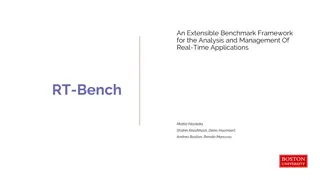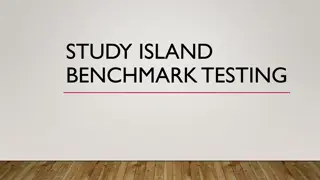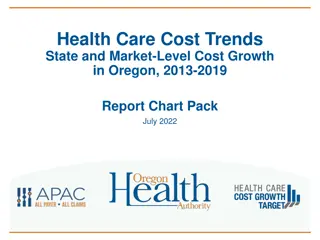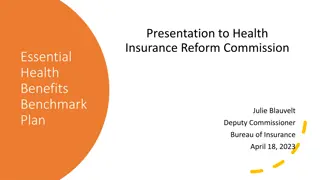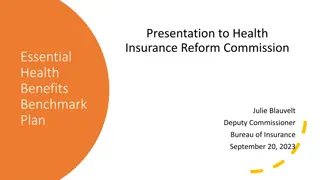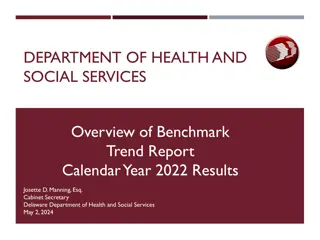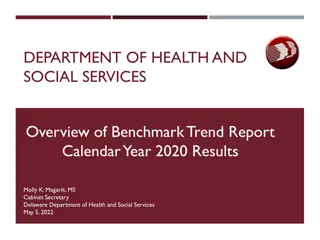Cost Growth Benchmark Technical Team Meeting Overview
During the Cost Growth Benchmark Technical Team Meeting, topics such as public comment, charter and bylaws, and the role of the technical team in program development were discussed. The team reviewed state health care cost growth benchmarks and primary care targets, highlighting the importance of health equity in their recommendations. The meeting facilitated discussions through Zoom, outlining procedures for questions and comments. Objective setting and achieving steps were outlined, emphasizing the team's role in recommending annual cost growth benchmarks and primary care spending targets.
Download Presentation

Please find below an Image/Link to download the presentation.
The content on the website is provided AS IS for your information and personal use only. It may not be sold, licensed, or shared on other websites without obtaining consent from the author.If you encounter any issues during the download, it is possible that the publisher has removed the file from their server.
You are allowed to download the files provided on this website for personal or commercial use, subject to the condition that they are used lawfully. All files are the property of their respective owners.
The content on the website is provided AS IS for your information and personal use only. It may not be sold, licensed, or shared on other websites without obtaining consent from the author.
E N D
Presentation Transcript
Cost Growth Benchmark Technical Team Meeting #2 May 5, 2020
Agenda Time 3:00 p.m. 3:10 p.m. 3:20 p.m. 3:30 p.m. Topic Call to Order and Introductions Public Comment Charter and Bylaws Role of the Technical Team in the Development of Connecticut s Program Review of Other States' Health Care Cost Growth Benchmark and Primary Care Target Programs Wrap-up & Next Steps Adjourn 4:00 p.m. 4:50 p.m. 5:00 p.m. 2
Process for Facilitating Discussion via Zoom 1. We will mute everyone to avoid background noise. 2. We invite members of the technical team to "raise your hand" to ask a question or make a comment. Just click on the "Participants" button at the bottom of your screen. Click the hand icon to "raise" your hand; click it again to "lower" your hand. 3. When we call on you, please click the microphone icon to unmute yourself. Please mute your microphone when you are done speaking. 4. You may send us a comment at any time in the Zoom chat box at the bottom of your screen. 5
Objectives of Cost Growth Benchmark Technical Team The Technical Team s charge is to meet the following objectives per Executive Order #5: 1. Recommend annual cost growth benchmarks across all payers and populations for CYs 2021-2025 by maximizing the use of work from Connecticut and other states, including best-in-class efforts and existing cost growth benchmarks, and adapt approaches for CT. 2. Recommend primary care spending targets across all payers and populations as a share of total health care expenditures for CYs 2021- 2025 to reach a target of 10% by 2025. 3. Center health equity in recommendations. 8
Achieving the Objectives: Seven Steps 1. Convene bimonthly or monthly between March and September to develop the cost growth benchmark and primary care targets The quality benchmarks will be developed subsequently for 2022 implementation. 2. Convene or reconvene design groups as needed to address specific aspects of the model, such as: the Practice Transformation Task Force and MAPOC for primary care target development considerations the Quality Council for identifying and aligning quality measures 9
Achieving the Objectives: Seven Steps 3. Consider and incorporate stakeholder input from consumers, providers, payers and employers via the Cost Growth Benchmark Stakeholder Advisory Board and other councils/boards and industry groups 4. Define minimum requirements or develop clear information on data collection needs 5. Define expenses to be included in the numerator or denominator for primary care and total health care expenditures 6. Recommend methods of analysis to ensure credibility and validity of measures 7. Recommend minimally burdensome data collection and analysis that are aligned across payers and providers for comparable populations 10
Connecticuts Cost Growth and Quality Benchmark, and Primary Care Target Program Role of the Technical Team 11
Connecticut Benchmarks and Target Program 1 2 3 4 Cost Growth Benchmark The Technical Team is to develop recommendations for a cost growth benchmark that covers all payers and all populations for 2021-2025. The Technical Team is to develop recommendations for a primary care target that applies to all payers and populations as a share of total health care expenditures for CY 2021-2025. Primary Care Target This is a complementary strategy that leverages the state s APCD to analyze cost and cost growth drivers. The Technical Team will provide input into this strategy. Data Use Strategy Beginning in CY 2022, quality benchmarks are to be applied to all public and private payers. This work will be coordinated through OHS, DSS and the OHS Quality Council. Quality Benchmarks
Connecticut Benchmark Program: Key Deliberating Bodies The Connecticut Benchmark Program will be established with the support of key deliberating bodies; the primary body is the Technical Team. The Stakeholder Advisory Board is charged with providing input to the Technical Team on the development of the cost growth target and primary care target. The Quality Council will be charged with developing the Quality Benchmarks with support from OHS and DSS. Other bodies, such as the OHS Consumer Advisory Council, Health Care Cabinet, Practice Transformation Task Force, MAPOC, and other stakeholders will be consulted and will feed into the Stakeholder Advisory Board. 13
1 The Technical Team is to develop recommendations for a cost growth benchmark that covers all payers and all populations for 2021-2025. Cost Growth Benchmark To develop recommendations for a cost growth benchmark, we will focus on two areas: 1. What health care spending is to be measured? While EO 5 defined total health care expenditures as the per capita sum of all health care expenditures in this state from public and private sources for a given calendar year there are many nuances to measuring total health care expenditures. For example, will we measure the health care expenditures of Connecticut residents, and/or individuals employed by Connecticut employers? 2. How will the cost growth benchmark be set? The Technical Team must develop a methodology to establish a cost growth benchmark. For example, will the Technical Team wish to base the benchmark to a measure of the State s economy? If yes, what indicator. 14
1 The Technical Team is to develop recommendations for a cost growth benchmark that covers all payers and all populations for 2021-2025. Cost Growth Benchmark Over the course of these meetings, we will present you a series of questions that will inform the cost growth benchmark recommendation. For each of the questions, we will provide you with pros/cons to each approach and information on what decisions the other four states have made, and why. We will review the Stakeholder Advisory Board feedback with you before any recommendation is finalized. 15
2 The Technical Team is to develop recommendations for a primary care target that applies to all payers and populations as a share of total health care expenditures for CY 2021-2025. Primary Care Target The Technical Team will need to weigh in on two aspects of the primary care target: 1. How is primary care defined and how will spending on primary care be measured? Primary care consists of more than just professional office visit codes and requires a thoughtful discussion of what services are included. Thought also needs to be given to defining who is a primary care provider. 2. What incremental primary care spend targets should lead up to 10% by 2025, and how should they be determined? The Technical Team will need to consider what the methodology for establishing incremental targets may be. 16
2 The Technical Team is to develop recommendations for a primary care target that applies to all payers and populations as a share of total health care expenditures for CY 2021-2025. Primary Care Target We anticipate starting this discussion in June and will begin with education on the experience of other states with primary care targets. We will share information on studies done on Connecticut s primary care spending by payer type, including PCC and NESCSO work. Discussion will take place over three meetings. We will present you with options, and pros/cons to inform your deliberation. We will review the Stakeholder Advisory Board feedback with you before any recommendation is finalized. 17
3 This is a complementary strategy that leverages the state s APCD to analyze cost and cost growth drivers. The Technical Team will provide input into this strategy. Data Use Strategy The Data Use Strategy is a complementary strategy that will be moving forward parallel to the establishment of the Cost Growth Benchmark and Primary Care Targets. Bailit Health s partner, Mathematica, will be developing recommendations and will work with UConn AIMS and OHS on how to utilize the APCD to analyze cost and cost growth drivers so that performance against the cost growth benchmarks, primary care targets and eventual quality benchmarks can be understood. The Technical Team will be engaged in a discussion of what types of analyses should be routinely produced, and how those analyses might support insurers, providers, consumers, purchasers and policymakers to take action. We anticipate discussing this during our July meetings. 18
19 Plan of Meetings (slide 1 of 3) Meeting # Date May, Date TBD Meeting Goals Review key questions for measuring total health care expenditures: What are total health care expenditures? What sources of coverage are included? Measure health care spending of Connecticut residents only? 3 Review key questions for benchmark methodology: How to identify benchmark value? Special conditions under which benchmark may be modified? Measuring total health care expenditures: Review outstanding questions/issues 4 June, Date TBD Key information about benchmark methodology: Review possible values of benchmark Develop recommendations on value of benchmark and possible modifications to annual benchmarks over time
20 Plan of Meetings (slide 2 of 3) Meeting # Date Meeting Goals 5 June, Date TBD Discuss possible modifications based on stakeholder input Finalize cost growth benchmark recommendation for 2021-2025 Health care cost growth benchmark: Review input from SAB and others on possible values of benchmark Primary care spending target: Review primary care spending targets in other states Data use strategy: Provide input on goals of a supplemental strategy to use APCD or other data to identify health care cost and cost growth drivers, and primary audiences for such analyses 6 July, Date TBD Primary care spending target: Provide input on definition of primary care Advise on creation of code-level definition of primary care spending Provide guidance on how to phase target to reach spending goal of 10% by 2025
21 Plan of Meetings (slide 3 of 3) Meeting # Date July Date TBD Meeting Goals Date use strategy: Review input from SAB and other stakeholders on data use strategy Refine recommendations on prioritized data use strategy analyses 7 Primary care spending target: Review input from SAB and other stakeholders on primary care spending target definitions and goals Review updated materials on primary care spending target Make recommendations on primary care spending target for 2021-2025 Recommendations: Review draft final cost growth target recommendations for implementation and SAB feedback Transparency of performance Review any outstanding issues, and reserve for "spill-over" topics Review final recommendations for implementation August Date TBD September 8 9
Review of Other States Health Care Cost Growth Benchmark Programs 23
What Is a Cost Growth Benchmark? A health care cost growth benchmark is a per annum rate-of-growth benchmark for health care costs in the state. When implemented, Connecticut will be the 5th state to have a statewide cost growth benchmark. January to add bullseye slide. 24
You say tomato, and I like to-mah-to. States have established both cost growth target and cost growth benchmark programs. What s the difference? State preference! 25
Why Have States Pursued Cost Growth Targets? Four other states have established cost growth benchmark programs similar to what Connecticut is developing: Massachusetts, Delaware, Rhode Island and Oregon. Each has done so for similar reasons as Connecticut: health care is unaffordable for the state and consumers. In MA state purchased health care rose 40% over 12 years while spending on all other services was (e.g., education, public health) was reduced by 17% on average. In OR, premiums equated to 29% of a family s total income. In RI, seven out of ten health insurance rate filings in the large and small group market outpaced annual wage growth. 26
Review of Other States Health Care Cost Growth Benchmark Programs The following slides review details of these states benchmark program, including: Enabling legislative, regulatory or administrative requirements Benchmark and supporting methodology Assessing performance against the benchmark Data sources to assess performance Enforcement of the benchmark Refresher on cost growth benchmark experience (Massachusetts only) 27
Massachusetts Health Care Cost Growth Benchmark Program 28
Massachusetts Enabling Legislative, Regulatory or Administrative Requirements Chapter 224 of the Acts of 2012 established health care cost growth benchmarks as part of sweeping health system reforms. Chapter 224 created two entities: Health Policy Commission (HPC) to set and enforce the benchmark Center for Information and Analysis (CHIA) to collect and measure health system performance against the benchmark. 29
Massachusetts Cost Growth Benchmark and Methodology Benchmarks amounts are set in statute and pegged to Potential Gross State Product (PGSP), a forecasted average growth rate of the state s economy, according to the following rules: 2013 2017: equivalent to PGSP (calculated at 3.6%) 2018 2022: PGSP minus 0.5% (or 3.1%), unless the HPC votes that an adjustment is warranted (requires 2/3 majority) 2023 and beyond: equivalent to PGSP, with authority for the HPC to adjust it to any value 30
Massachusetts Methodology for Assessing Performance Against the Benchmark Performance against the benchmark is measured using Total Health Care Expenditures (THCE), a measure of health care spending by and for MA residents from public and private sources. THCE consists of: 1. Total Medical Expense (TME) spending on all medical services for all MA residents regardless of where care was provided, including non-claims- related payments to providers 2. Patient cost-sharing 3. Net Cost of Private Health Insurance (NCPHI), a measure of the costs to MA residents associated with administration of private health insurance (including Medicare Advantage and Medicaid managed care) 31
Massachusetts Methodology for Assessing Performance Against the Benchmark THCE does not include: 1. Non-medical spending made by payers (e.g., gym membership) 2. Vision or dental care not otherwise covered by a medical plan 3. Expenditures recorded by providers, but not insurers (e.g., spending for uninsured residents) 32
Massachusetts Data Sources Used to Calculate Performance Against the Benchmark Commercial insurers submit TME summary-level information, including: Allowed amount expenditures made on behalf of MA residents, which includes patient cost-sharing Fully-insured and self-insured Medicare Advantage, Medicaid MCOs, and dual eligibles products Payer completion factor adjustment to estimate costs that have been incurred but not reported (IBNR) For carved-out services (behavioral health, pharmacy), CHIA makes actuarial adjustments 33
Massachusetts Data Sources Used to Calculate Performance Against the Benchmark Insurers submit spending, with specific definitions, according to the following categories: 1. Hospital inpatient 2. Hospital outpatient 3. Pharmacy 4. Physician 5. Other professionals 6. Other medical (e.g., long-term care) 7. Non-claims (e.g., performance incentives, capitation, risk-based payment settlements) 34
Massachusetts Data Sources Used to Calculate Performance Against the Benchmark CHIA also collects medical expenses for other payers that don t report TME, including: Medicaid primary care case management program and other fee-for- service data from the Medicaid agency Medicare Part A and/or B and stand-alone Part D membership and expenditure data from CMS Other sources of health spending (e.g., Veterans Health Administration) 35
Massachusetts Enforcement of the Benchmark The HPC has authority to require providers whose cost growth exceeds the benchmark to implement a performance improvement plan (PIP) and levy penalties of up to $500,000 for noncompliance with the PIP. Entities undergoing a PIP are required to update the HPC on their PIP progress and are eligible for technical assistance from the HPC. In years when the state exceeds the benchmark, the HPC may conduct a review of one or more of these entities. To date, there have been referrals, but no PIPs. 36
Massachusetts Cost Growth Benchmark Experience From 2012 to 2018, annual health care spending growth averaged 3.38%, below the state benchmark. Commercial spending growth in Massachusetts has been below the national rate every year since 2013. 37
Policy Experts Assessment of the Benchmark Program s Impact Payer and provider rate negotiations are now conducted in light of the 3.6% target. State Auditor study With an expected utilization increase of about 2%, payers and providers generally agree on annual price increases of about 1.5%. David Cutler, HPC member The [cost growth benchmark] does mean something It s more than just a symbol, it becomes an operational component of how our health system works. Stuart Altman, HPC Chair 38
Delawares Health Care Spending and Quality Benchmarks Program 40
Delawares Enabling Legislative, Regulatory or Administrative Requirements House Resolution 7 passed in September 2017 to establish and plan for monitoring and implementation of annual health care benchmark. The DE Department of Health and Social Services (DHSS) subsequently developed a public and private all-payer cost-benchmarking program and advisory group. In November 2018 Governor Carney issued Executive Order 25 to formally establish the health care spending and quality benchmarks. The DE Health Care Commission (DHCC) and DE Economic and Financial Advisory Council (DEFAC) Health Care Spending Benchmark Committee oversee the program. 41
Delawares Health Care Spending Benchmark and Methodology The benchmark is set at the state s PGSP (3.0%) with transitional adjustments: 2019: 3.80% 2020: 3.50% 2021: 3.25% 2022 and 2023: 3.00% Annually, a subcommittee of DEFAC reviews all components of PGSP and recommends whether it has changed in a material way and warrants a change in the target. The DEFAC subcommittee will consider whether the spending target s methodology should be updated or changed for future years by March 2023. 42
Delawares Quality Benchmarks Delaware also set eight quality targets for ongoing reference in its annual benchmarking program: 1. Adult obesity 2. High school students physically active 3. Opioid-related overdose deaths 4. Tobacco use 5. Concurrent use of opioids and benzodiazepines* 6. ED utilization (commercial only) 7. Persistence of beta blocker treatment after heart attach 8. Statin therapy adherence for patients with cardiovascular disease * This measure was originally included in the Executive Order but will be replaced with another opioid use measure 43
Rhode Islands Health Care Cost Growth Target Program 44
Rhode Islands Enabling Legislative, Regulatory or Administrative Requirements In 2016, Governor Raimondo asked a group of health care provider and insurer leaders to recommend a method for setting a cost growth benchmark for the state. They did so by year end. In 2018 the state secured foundation funding to launch a more public and broadly inclusive effort to establish a cost growth benchmark and establish a means to leverage the state s all-payer claims database (APCD) to highlight spending patterns and trends. In August 2018, the Executive Office of Health and Human Services, Office of the Health Insurance Commissioner and Governor s Office convened a Steering Committee comprised of 18 diverse RI stakeholders to advise on cost growth target recommendations. 45
Rhode Islands Enabling Legislative, Regulatory or Administrative Requirements The Steering Committee made recommendations in November 2018, and in December 2018 signed a voluntary compact, which remains in effect through December 2022, to meet the state s target. Governor Raimondo established the target in February 2019 through Executive Order 19-03. The State administers and implement the benchmark program, with ongoing advice and support from its Steering Committee. 46
Rhode Islands Cost Growth Benchmark and Methodology The benchmark was established by the Steering Committee and set to the state s PGSP as calculated in 2018. 2019 2022: 3.2% 2023 and beyond: to be re-evaluated and determined in 2022 The compact stipulates that only highly significant changes in the economy will trigger re-visiting of the target methodology, and that the Steering Committee will work with the State to determine a functional definition of highly significant. The benchmark is coupled with a data analysis strategy that leverage s the state s all-payer claims database to give providers and policymakers information to manage health care cost growth. 47
Delaware and Rhode Islands Benchmark Programs Are Largely Modeled Off Massachusetts DE and RI use THCE to measure performance against the benchmark Insurers submit per member per year TME for the commercial fully and self-insured, Medicare Advantage, and Medicaid managed care. Both states intend to publish performance at the state, market, insurer and provider levels for the purposes of transparency. The details that vary in each state will be reviewed when we discuss key questions related to the establishment of Connecticut s program. 48
Oregons Sustainable Health Care Cost Growth Target Program 50











